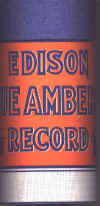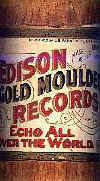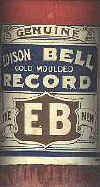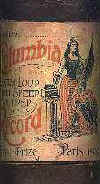Introduction
Commercial entertainment cylinders were available from the early 1890s through to June 1929. At first of wax, then of durable celluloid, their smooth surfaces and bright, clear recording made them an attractive alternative to contemporary discs, and if they did not achieve the imaginative repertoire of the disc catalogues, cylinder companies nevertheless managed to cover most of the music then thought recordable.
Cylinders are of three basic types:
Brown Wax Duplicated 2 Minute:
From about 1890 to 1904, these are the earliest and were cut individually from the master record, usually by means of a pantographic duplicating machine. For double the price, you could buy an original master which gave excellent sound. In this category of duplicated cylinders, you also find the 5inch diameter concert cylinder which was developed for its great definition and volume. Speeds are usually 120 to 144 rpm.
Moulded 2 Minute:
Introduced in 1902 by Edison and Columbia, these fine records gave just over 2 minutes playing time at 160 rpm. They are usually of a black wax-like metallic soap compound, though the first Columbias are brown. In 1903, Edison Bell brought out a moulded cylinder running at 144 to 155 rpm. From 1905, cylinders of most makes have the title in white lettering moulded into the top or finish end. As well as wax cylinders, you also find celluloid cylinders from this period, termed “indestructible”. They come in black, brown and a magnificent pink celluloid, and are comparatively rare, because although durable, they were scratchy compared to new wax cylinders. In old age, they have often shrunk or split. The last wax 2 minute cylinders were issued by Clarion in 1923.
The 4 Minute Record:
Cylinders were handicapped by their short playing time which prevented their appealing to serious music lovers without making the most appalling cuts in the music. The solution was found by Edison in 1908, who, by doubling the number of grooves to the inch from 100 to 200, could also double the playing time on a standard size cylinder. Gearing and attachments were introduced to adapt all existing machines to play both the 2 minute standard and the new 4 minute Amberol records. The new format was a great success, though problems of wear arose because the same stylus pressure needed to produce good sound, now had to be borne by a waxen groove half the size. Columbia came up with an excellent celluloid cylinder which solved the problem in 1909, and Edison followed suite in 1912 with his Blue Amberol which remained in production until June 1929. These have magnificent sound and are the best for the collector who wishes to listen to his or her phonograph. Unfortunately, from 1915, they were dubbed from the Edison discs and lose some sound quality which resulted in the later ones being referred to as “Damberols”
Sources:
Cylinders seldom turn up in your neighbourhood antique shop any more, but may be found in London and provincial auction houses, usually in the category of “Mechanical Music”. Otherwise, Ebay on the internet is the most abundant and regular source for the collector. There are also a number of good postal auctions run by dealers and collectors, especially from the States. Once again, the internet supplies the necessary information. Try search words like “Phonograph”, “Edison”, etc.




